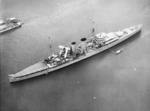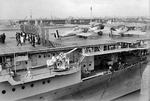Exeter
| Country | United Kingdom |
| Ship Class | York-class Heavy Cruiser |
| Hull Number | 68 |
| Builder | Devonport Dockyard, Plymouth, England, United Kingdom |
| Laid Down | 1 Aug 1928 |
| Launched | 18 Jul 1928 |
| Commissioned | 27 Jul 1931 |
| Sunk | 1 Mar 1942 |
| Displacement | 8,390 tons standard; 10,490 tons full |
| Length | 575 feet |
| Beam | 58 feet |
| Draft | 17 feet |
| Machinery | Four geared steam turbines driving four shafts; eight Yarrow oil-fired 3-drum boilers |
| Bunkerage | 1900 tons oil |
| Power Output | 80,000 shaft horsepower |
| Speed | 32 knots |
| Range | 10,000nm at 11-14 knots |
| Crew | 628 |
| Armament | 3x2x8in Mk VIII guns, 4x4in QF Mk V AA guns, 2x2pdr Vickers pom-pom AA guns, 2x3x21in torpedo tubes |
| Armor | 76mm belt, 38mm deck, 25mm barbettes, 25mm turrets, 76-140mm magazines, 111mm bulkheads |
| Aircraft | 2 seaplanes |
| Catapults | 2 |
Contributor: Alan Chanter
ww2dbaseDesigned by Sir William Berry as a smaller version of the County-class cruisers which, at a cost of nearly £2,000,000 each were considered over expensive, the two York-class cruisers had the same machinery fit but were nearly 17 metres shorter in length. The primary difference between the York- and County-class cruisers however was that the former's forecastle deck now terminated amidships and one of the aft 8-inch main turret and four of the 4-inch secondary battery were eliminated. Although five vessels in this class were originally projected, only two, HMS York and HMS Exeter, were actually completed. These two were quite different in profile - The Exeter was originally intended to have had three raking funnels and an aircraft catapult located on its raised B turret with masts spaced as in the York. But, on completion, the foremost funnel was trunked into the second to improve the habitability of the bridge (lowered so that the director was only 60 feet above water level), which saved both space and weight, and the turret catapult was dispensed with. Protection consisted of 76 millimeters of side armour and 50 millimeters for the decks and turrets. Also HMS York had an old style bridge while the Exeter had an increase in beam of 30 centimeters and a more compact 1930s style bridge structure without wings.
ww2dbaseExeter was laid down at the Devonport Dockyard in southern England, United Kingdom on 1 Aug 1928, launched on 13 Jul 1929 and commissioned for service with the 2nd Cruiser Squadron of the Atlantic Fleet. In Sep 1931 the Invergordon mutiny took place within the Atlantic Fleet. This mutiny resulted from a government announcement that proposed pay cuts for naval personnel. Being newly commissioned the crew of the Exeter, although obviously sympathetic did not play a part. Through the 1930s the Exeter saw extensive service in the Atlantic and Mediterranean and then, at the outbreak of World War II, she was deployed to the West Indies to provide protection to Allied shipping in the south Atlantic.
ww2dbaseIn Oct 1939, the Exeter joined Commodore Henry Harwood's Force G which consisted of the cruisers HMS Ajax (Captain C. H. L. Woodhouse, R. N.), HMNZN Achilles (Captain W. E. Parry, R. N.) and the Exeter (Captain F. S. Bell, R. N.) - a fourth cruiser, HMS Cumberland, was refitting - to hunt for the fast heavily-armed German pocket battleship Admiral Graf Spee (Kapitan zur See Hans Langsdorff) which was wreaking havoc in the south Atlantic. By Dec 1939 the Graf Spee had sunk eight ships in the Atlantic as well as another in the Indian Ocean (a total of some 50,000 tons of shipping). Two of her last victims, the SS Doric Star (sunk on 2 Dec) and SS Tairoa (3 Dec) had succeeded in transmitting wireless signals reporting their positions when attacked, and it was from these that Commodore Harwood deduced that Langsdorff's three likeliest next destinations could be either Rio de Janeiro, the Falkland Islands or the River Plate. He opted to head towards Uruguay.
ww2dbaseAt dawn on 13 Dec, Graf Spee, which had been moving towards the South American coast in search of more victims, sighted Exeter and closed at full speed, believing her to be part of a convoy escort. At 0617 hours Graf Spee opened fire, beginning the Battle of the River Plate (q.v.) in which the Exeter, Ajax and Achilles would heroically engage their heavier armed adversary. During the battle Exeter bore up against 40 to 50 hits, many of them from shells three times the weight of those she could fire back; three of her 8-inch guns in her thinly armoured forward turrets were smashed, and sixty-one member of her crew killed with twenty-three other sailors wounded. Only when the after turret lost all power did Captain Bell order a break-off. Despite her damage the Exeter nonetheless remained on station outside Montevideo ready to take part in any renewed action, only departing to care for the wounded and make repairs when relieved by the arrival of HMS Cumberland.
ww2dbaseThe extensive damage suffered during the battle would require repairs that kept HMS Exeter out of the war for more than a year, after which she spent the remainder of 1941 engaged on routine convoy escorts. When the Pacific War commenced in Dec 1941 Exeter was ordered to Singapore to conduct more convoy escort duties during the Malayan and Dutch East Indies campaigns. Then, on 13 Feb 1942, Allied reconnaissance aircraft discovered a Japanese invasion convoy to the north of Banga Island. A strike force, under the command of Rear Admiral Karel Doorman, consisting of the Exeter, three Dutch and one Australian light cruisers and escorted by six American and three Dutch destroyers set off that afternoon to intercept. Continuous air attacks on the Allied fleet throughout the following day quickly convinced Admiral Doorman that it was unwise to continue in the face of such overwhelming Japanese air superiority and, although none of his ships had incurred more than slight damage, he ordered the fleet to divert to Batavia, Dutch East Indies.
ww2dbaseOn 27 Feb 1942, during the first Battle of the Java Sea, Exeter suffered major damage when a shell from the Japanese heavy cruiser Hagura exploded in the forward boiler room. Disabled the Exeter sheered out of line and slowed. The Australian light cruiser Perth closed to lay a smoke screen to protect the Exeter as she disengaged from the action escorted by one Dutch and three British destroyers. When Japanese destroyers began launching torpedoes, the Royal Navy destroyers Encounter and Electra pulled away to counter-attack damaging the Japanese destroyer Asagumo but losing the Electra sunk in return. Exeter, escorted by Encounter and the Dutch destroyer Witte de With, could only make five knots, fled south to Surabaya.
ww2dbaseAfter emergency repairs, HMS Exeter, escorted by the destroyers HMS Encounter and USS Pope, sailed at dusk on 28 Feb 1942, for more extensive repairs in Ceylon. As Exeter had too much draft for the Bali Strait, it was decided to go via the Sunda Strait, which was thought to be still open. The morning of 1 Mar 1942 found the three Allied warships (making 23 knots - as much as Exeter could manage) west-northwest of Bawean Island and heading westwards. Through that morning Japanese surface and air forces commenced attacks midway between the islands of Java and Borneo. As they attempted to escape the Allied ships, fought a fierce three-hour action, against no less than four Japanese heavy cruisers and four destroyers, damaging a number of the Japanese ships. Pope alone fired all of her torpedoes and 140 salvoes of naval gunfire. But shortly before noon both Exeter and Encounter had been sunk by gunfire, and an hour later, Pope was attacked and sunk by twelve dive-bombers - after sustaining many bomb hits. There were just over 800 survivors picked up and imprisoned by the Japanese, of which 190 would later die in captivity.
ww2dbaseSources:
Warships of World War II (Collins-Jane's, 1996)
Walter Hutchinson (Editor), Pictorial History of the War Volume 2 (Library Press -date unknown)
John Winton, The War at Sea (Book Club Associates, 1974)
Jane's Fighting Ships of World War II (Studio Publishing, 2001)
Last Major Revision: May 2017
Heavy Cruiser Exeter (68) Interactive Map
Photographs
 |  |  |  |
Exeter Operational Timeline
| 15 Mar 1928 | HMS Exeter was ordered. |
| 1 Aug 1928 | The keel of HMS Exeter was laid down at Devonport Dockyard, Plymouth, England, United Kingdom. |
| 18 Jul 1929 | HMS Exeter was launched at Devonport Dockyard, Plymouth, England, United Kingdom. |
| 27 Jul 1931 | HMS Exeter was commissioned into service. |
| 5 Oct 1939 | HMS Cumberland after refueling at Freetown, British West Africa (now Sierra Leone) was sent to join cruisers Exeter, Achilles and Ajax for continuation of interception patrols as Force G. |
| 13 Dec 1939 | At the Battle of the River Plate, British naval forces damaged German pocket battleship Admiral Graf Spee, forcing her enter the neutral port of Montevideo for repairs. HMS Cumberland was ordered to join Exeter, Ajax and Achilles off the Plate estuary off Uruguay. |
| 28 Feb 1942 | British cruiser HMS Exeter departed Surabaya, Java, Dutch East Indies for Ceylon. |
| 1 Mar 1942 | HMS Encounter, HMS Exeter, and USS Pope were sunk at the Second Battle of the Java Sea; the ships suffered 7, 54, and 1 killed, respectively. Meanwhile, at the Battle of Sunda Strait, Allied cruisers USS Houston and HMAS Perth intercepted a Japanese invasion force but were both sunk as they attacked; four Japanese transports and a minesweepers were sunk, but two of the transports were later refloated. Also on this date, Japanese troops landed on Java and immediately began marching for Batavia, with the Japanese 2nd Division capturing Serang and the 230th Infantry Regiment capturing Kalidjati airfield at Soebang en route. Finally, Japanese air raids at Surabaya damaged destroyer USS Stewart and Dutch destroyer Witte de With. |
| 1 Mar 1942 | HMS Exeter was sunk during the Second Battle of the Java Sea shortly after 1200 hours. |
Please consider supporting us on Patreon. Even $1 per month will go a long way! Thank you. Please help us spread the word: Stay updated with WW2DB: |

» Battle of the River Plate
» Dutch East Indies Campaign, Java
- » 1,178 biographies
- » 337 events
- » 45,081 timeline entries
- » 1,245 ships
- » 350 aircraft models
- » 207 vehicle models
- » 376 weapon models
- » 123 historical documents
- » 261 facilities
- » 470 book reviews
- » 28,491 photos
- » 365 maps
Fleet Admiral Chester W. Nimitz, 16 Mar 1945
Please consider supporting us on Patreon. Even $1 a month will go a long way. Thank you!
Or, please support us by purchasing some WW2DB merchandise at TeeSpring, Thank you!